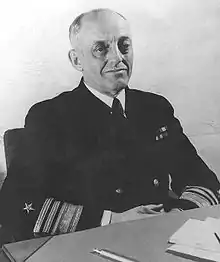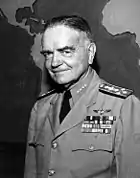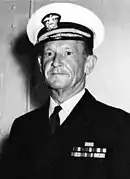Guadalcanal naval order of battle
On 7 August 1942, US and Australian naval forces undertook the invasion of the Japanese-held islands of Guadalcanal and Tulagi in the lower Solomon Islands chain, the first Allied offensive in the Pacific Theatre. The landing of the US 1st Marine Division on the beaches of Savo Sound began the unexpectedly long and extremely arduous Guadalcanal Campaign, lasting officially until 9 February 1943.

The naval forces dedicated to Operation Watchtower were minuscule compared to those deployed for later Allied offensives such as the invasion of the Gilberts and the capture of Okinawa. This is owing to the commitment the United States had made to Great Britain to undertake the invasion of North Africa in the fall of 1942, a commitment which essentially left the Guadalcanal operation with the naval leftovers. For this reason, American sailors and Marines referred to the invasion as "Operation Shoestring".[1]
![]()
3 fleet carriers, 1 fast battleship, 9 heavy cruisers, 2 anti-aircraft light cruisers, 31 destroyers
![]()
13 transports, 6 attack cargo ships, 4 destroyer transports
![]()
5 fast minesweepers, 5 oilers
![]()
2 heavy cruisers, 1 light cruiser
Command structure





Theater command
The roles of Commander in Chief, Pacific Ocean Areas (CINCPOA) and Commander in Chief, U.S. Pacific Fleet (CINCPAC), were both exercised by Admiral Chester W. Nimitz from his headquarters at Pearl Harbor, Hawaii.
Since the Solomons lie in the Southern Pacific, the landings of 7 August 1942 on Guadalcanal were the responsibility of the South Pacific Fleet, led by Vice Admiral Robert L. Ghormley from his headquarters at Noumea, New Caledonia.[2] Adm. Ghormley's pessimism, inadequate staff work and unwillingness to visit the front led Adm. Nimitz to replace him with the much more aggressive and hands-on Vice Admiral William F. Halsey on 18 October 1942.[3]
Operational command
Operational command of the invasion was assigned to Vice Admiral Frank Jack Fletcher, who also had direct command of the covering force, designated Task Force 61, where he flew his flag aboard fleet carrier Saratoga. This embodiment of two levels of command in a single officer enabled a decision-making process that left the Marine forces on Guadalcanal essentially stranded and short-supplied. The amphibious forces, Task Force 62, were led by Rear Admiral Richmond Kelly Turner aboard transport McCawley.
Bitter disputes between the two men arose during both the planning and execution of the invasion over how long Fletcher's aircraft carriers would stay in the vicinity of Guadalcanal to provide air cover for the Marines ashore. Fletcher decided the matter after multiple assaults on the Allied amphibious task force by bombers from the Japanese base at Rabaul on D-Day and D+1. These attacks convinced Fletcher that his crucial aircraft carriers could not be risked in the waters of the Solomons any longer and he ordered his carriers along with Turner's still-half-full cargo ships out of the area on the night of 8 August. This decision resulted in much hard feeling among the Marines ashore, who felt that the Navy had abandoned them.
Forces afloat
Expeditionary Force (Task Force 61)
Vice Admiral Frank Jack Fletcher
Air Support Force (Task Group 61.1)


_underway_at_sea_on_16_October_1942_(NH_97807).jpg.webp)
Rear Admiral Leigh Noyes
- Task Unit under Vice Admiral Fletcher
- Vice Adm. Fletcher
- 1 fleet carrier
- Saratoga (Capt. DeWitt C. Ramsey)
- Air Group (Cmdr. Harry D. Felt)
- VF-5: 34 F4F Wildcat fighters (Lt. Cmdr. Leroy C. Sampler)
- VB-3: 18 SBD Dauntless dive bombers (Lt. Cmdr. Dewitt W. Shumway)
- VS-3: 18 SBD Dauntless scout bombers (Lt. Cmdr. Louis J. Kirn)
- VT-8: 16 TBF Avenger torpedo bombers (Lt. Harold H. Larsen)
- Air Group (Cmdr. Harry D. Felt)
- Saratoga (Capt. DeWitt C. Ramsey)
- 2 heavy cruisers (both New Orleans-class)
- Minneapolis (Capt. Frank J. Lowry)
- New Orleans (Capt. Walter S. DeLany)
- Screen (Capt. Samuel B. Brewer)
- 5 destroyers
- 1 Porter-class (8 x 5-in. main battery): Phelps
- 4 Farragut-class (5 x 5-in. main battery): Farragut, MacDonough, Dale, Worden
- 5 destroyers
- 1 fleet carrier
- Task Unit from old Task Force 16
- Rear Admiral Thomas C. Kinkaid
- 1 fleet carrier
- Enterprise (Capt. Arthur C. Davis)
- Air Group (Lt. Cmdr. Maxwell F. Leslie)
- VF-6: 36 F4F Wildcat fighters (Lt. Louis H. Bauer)
- VB-6: 18 SBD Dauntless dive bombers (Lt. Ray Davis)
- VS-5: 18 SBD Dauntless scout bombers (Lt. Turner F. Caldwell, Jr.)
- VT-3: 14 TBF Avenger torpedo bombers (Lt. Cmdr. Charles M. Jett)
- Air Group (Lt. Cmdr. Maxwell F. Leslie)
- Enterprise (Capt. Arthur C. Davis)
- 1 fast battleship (North Carolina-class)
- North Carolina (Capt. George H. Fort)
- 1 heavy cruiser (Portland-class)
- Portland (Capt. Laurance T. DuBose)
- 1 anti-aircraft light cruiser (Atlanta-class)[lower-alpha 1]
- Atlanta[lower-alpha 2] (Capt. Samuel P. Jenkins)
- Screen (Capt. Edward P. Sauer)
- 5 destroyers
- 2 Gleaves-class (5 x 5-in. main battery): Gwin, Grayson
- 1 Gridley-class (4 x 5-in. main battery): Maury
- 1 Benham-class (4 x 5-in. main battery): Benham[lower-alpha 3]
- 1 Porter-class (8 x 5-in. main battery): Balch
- 5 destroyers
- 1 fleet carrier
- Task Unit under Rear Admiral Noyes
%252C_August_1942.jpg.webp)
_off_the_Norfolk_Naval_Shipyard_on_6_February_1942_(19-N-30121).jpg.webp)
- Rear Admiral Noyes
- 1 fleet carrier
- Wasp[lower-alpha 4] (Capt. Forrest P. Sherman)
- Air Group (Lt. Cmdr. Wallace M. Beakley)
- VF-71: 29 F4F Wildcat fighters (Lt. Cmdr. Courtney Shands)
- VS-71: 15 SBD Dauntless scout bombers (Lt. Cmdr. John Eldridge, Jr.[lower-alpha 5])
- VS-72: 15 SBD Dauntless scout bombers (Lt. Cmdr. Ernest M. Snowden)
- VT-7: 9 TBF Avenger torpedo bombers (Lt. Henry A. Romberg)
- Air Group (Lt. Cmdr. Wallace M. Beakley)
- Wasp[lower-alpha 4] (Capt. Forrest P. Sherman)
- 2 heavy cruisers
- 1 New Orleans-class: San Francisco (Capt. Charles H. McMorris)
- 1 Pensacola-class: Salt Lake City (Capt. Ernest G. Small)
- Screen (Capt. Robert G. Tobin)
- 6 destroyers
- 2 Benson-class (4 x 5-in. main battery): Laffey[lower-alpha 6], Farenholt
- 1 Gleaves-class (4 x 5-in. main battery): Aaron Ward
- 3 Benham-class (4 x 5-in. main battery): Lang, Sterett, Stack
- 6 destroyers
- 1 fleet carrier
South Pacific Amphibious Force (Task Force 62)
Rear Admiral Richmond Kelly Turner in transport McCawley

_c1944.jpg.webp)
.jpg.webp)
- Convoy (Task Group 62.1)
- Captain Lawrence F. Reifsnider in transport Hunter Liggett
- Embarking 1st Marine Division (Maj. Gen. Alexander A. Vandegrift, USMC, Commander ground forces)
- Transport Group "X-Ray" – Guadalcanal Landings
- Capt. Reifsnider
- Transport Division A (Capt. Paul S. Theiss)
- Embarking 5th Marines less 2nd Battalion (Col. LeRoy P. Hunt, USMC)
- Transport Division B (Capt. Charlie P. McFeaters)
- Embarking Division HQ and 1st Marines (Col. Clifton B. Cates, USMC)
- Transport Division C (Capt. Lawrence F. Reifsnider)
- Embarking part of Support Group, Special Weapons Battalion, 5th Battalion / 11th Marines, part of 3rd Defense Battalion
- Transport Division D (Capt. Ingolf N. Kiland)
- Embarking 2nd Marines less 1st Battalion (Col. John M. Arthur, USMC)
- Transport Group "Yoke" – Tulagi Landings
- Capt. George B. Ashe
- Transport Division E (Capt. Ashe)
- Embarking 2nd Battalion / 5th Marines, 1st Battalion / 2nd Marines, 1st Parachute Battalion, Co. E / 1st Raider Battalion (Brig. Gen. William H. Rupertus, USMC)
- Transport Division 12 (Capt. Hugh W. Hadley)
- Embarking 1st Raider Battalion less Co. E (Lt. Col. Merritt A. Edson, USMC)
- Escort (Task Group 62.2)


_off_Tulagi%252C_7-8_August_1942_(AWM_P05292.016).jpg.webp)
_-_19-N-30508.jpg.webp)
- Rear Admiral Victor A.C. Crutchley, RN
- 3 heavy cruisers
- HMAS Australia (Capt. H.B. Farncomb, RAN)
- HMAS Canberra[lower-alpha 7] (Capt. F.E. Getting, RAN)
- Chicago[lower-alpha 8] (Capt. Howard D. Bode)
- 1 light cruiser
- HMAS Hobart (Capt. H.A. Showers, RAN)
- Screen (Capt. Cornelius W. Flynn)
- 9 destroyers
- 1 Porter-class (8 x 5-in. main battery): Selfridge
- 8 Bagley-class (4 x 5-in. main battery): Bagley, Blue[lower-alpha 9], Helm, Mugford, Ralph Talbot, Henley, Patterson, Jarvis[lower-alpha 10]
- 9 destroyers
- 3 heavy cruisers
- Fire Support Group L (Task Group 62.3)
- Captain Frederick Riefkohl[lower-alpha 11]
- 3 heavy cruisers
- 2 New Orleans-class: Vincennes[lower-alpha 12] (Capt. Frederick Riefkohl), Quincy[lower-alpha 13] (Capt. Samuel N. Moore)
- 1 Astoria-class: Astoria[lower-alpha 14] (Capt. William G. Greenman)
- 4 destroyers
- 2 Benham-class (4 x 5-in. main battery): Ellet, Wilson
- 2 Farragut-class (4 x 5-in. main battery): Hull, Dewey (Lt. Cmdr. Charles F. Chillingworth, Jr.)
- 3 heavy cruisers
- Fire Support Group M (Task Group 62.4)
- Rear Admiral Norman Scott[lower-alpha 15]
- 1 anti-aircraft light cruiser (Atlanta-class)[lower-alpha 16]
- San Juan (Capt. James E. Maher)
- 2 destroyers (both Gleaves-class)
- 1 anti-aircraft light cruiser (Atlanta-class)[lower-alpha 16]
Notes
- These cruisers were intended as destroyer leaders when designed. After the first two to be used in this role, Atlanta and Juneau, were lost at the Naval Battle of Guadalcanal, this mission was rejected and the anti-aircraft mission adopted.[4]
- Scuttled after receiving severe damage at Naval Battle of Guadalcanal, 13 November 1942
- Sunk at Naval Battle of Guadalcanal, 15 November 1942
- Scuttled after being torpedoed by I-19 south of Guadalcanal, 15 September 1942
- Killed during campaign
- Sunk by Hiei at Naval Battle of Guadalcanal, 13 November 1942
- Sunk at Battle of Savo Island, 9 August 1942
- Sunk by air attack during the Battle of Rennell Island, 30 January 1943
- Torpedoed by Kawakaze off Guadalcanal, 22 August 1942
- Sunk by air attack following Battle of Savo Island, 9 August 1942. Lt. Cmdr. Graham had had all lifeboats and rafts removed to save weight, so there were no survivors; the Jarvis was one of only two US vessels lost with all hands during the war.[5]
- Relieved of command following disastrous Battle of Savo Island
- Sunk at Battle of Savo Island, 9 August 1942
- Sunk at Battle of Savo Island, 9 August 1942
- Sunk at Battle of Savo Island, 9 August 1942
- Killed at Naval Battle of Guadalcanal, 13 November 1942
- These cruisers were intended as destroyer leaders when designed. After the first two to be used in this role, Atlanta and Juneau, were lost at the Naval Battle of Guadalcanal, this mission was rejected and the anti-aircraft mission adopted.[6]
References
- Morison 1949, p. 262
- Morison 1949, pp. 250-251
- Morison 1948, p. 183
- Stille, p. 7.
- Morison 1948, p. 52n
- Stille, p. 7
Bibliography
- Morison, Samuel Eliot (1949). Coral Sea, Midway and Submarine Actions, May 1942 – August 1942. History of United States Naval Operations in World War II. IV. Boston: Little, Brown and Co. ISBN 0-3165-8304-9.
- Morison, Samuel Eliot (1948). The Struggle for Guadalcanal, August 1942 – February 1943. History of United States Naval Operations in World War II. V. Boston: Little, Brown and Co. ISBN 0-7858-1306-3.
- Silverstone, Paul H. (1970). U.S. Warships of World War II. Garden City, NY: Doubleday and Co. ISBN 0-8702-1773-9.
- Stille, Mark (2016). US Navy Light Cruisers, 1941-45. Oxford: Osprey Publishing, Ltd. ISBN 978-1-4728-1140-0.